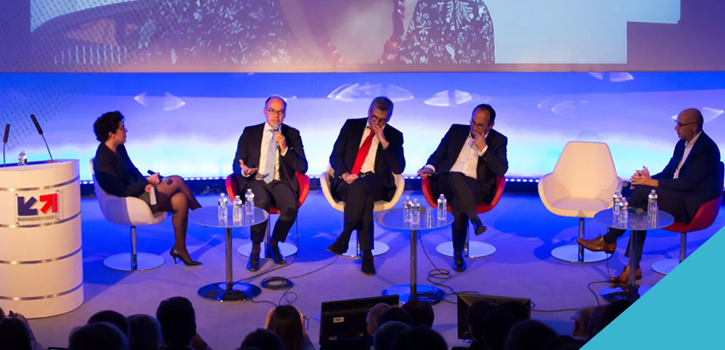The Rencontres Internationales du Marketing B2B (“International B2B Marketing Forum”) took place on October 25 at Business France as part of the La French Tech event series. This year the forum was organized by Aressy, Companeo, C-Radar, GetQuanty, Newslead, Stein IAS and TBMS.
Several speakers were on hand to share their experiences, advice and predictions about future trends in the field. Here are the key learnings from the keynote addresses and round tables:
1. If you are the leader in your domestic market, how do you take your brand international?
Your brand leads in the domestic market and you want to bolster your international presence. There are several paths you could take:
- Maintain your historic brand and adapt your discourse;
- Create a new brand;
- If you take the acquisition route, use the name of the newly acquired brand which already has a history in the market.
It sounds perfectly logical, but it is important to remember the basics, such as taking a close look at the competition: if there are lots of companies in the industry, it means the market has already been evangelized and the concept no longer needs proving. But if the sector is underdeveloped, you should begin by educating the market and asserting your brand as the only alternative…sometimes by acquiring new actors, as mentioned by Vilidiana Abou, Director of Marketing – France, for Regus. Regus, the worlds’s biggest provider of flexible business space, bought the Spaces company and retained its name because the brand was already very well positioned in the Dutch market.
It is also important to focus on newer aspects of brand imaging: although until recently we always talked about the 4P’s, according to Cécile Delettré (Evangelist & Business Development Manager at Business France) today what matters are the 4E’s: Engagement, Emotion, Experience and Event.
Another crucial factor delivering the same quality of service in all countries. Your brand must define identical standards in order to reassure consumers.
2. Start-ups, small businesses, major accounts: which strategies will help you land international customers?
Glocal marketing is the key
Think global, act local: that is the mantra promoted by Bruno Constans (Director of Marketing & Innovation at Gefco (the pre-emininent choice of manufacturers for worldwide supply chain management) and Cyril Kovarsky (former Director of International Sales at Accor Hotels). Digital tools considerably ease communication between different countries within the same company and, by extension, facilitate the coordination of global strategies.
At Accor, the entire global marketing team is based in Paris. But be careful! When you talk about the customer experience, you have to get local, i.e. go to the source! The roles of global marketing are to:
- Ensure the consistency of the message: remember that the customer can see the website for every country in a single click.
- Reduce costs and avoid the (oh-so-French) pitfall of replicating something locally when everything was carefully designed to be global.
- Implement controls with identical indicators to simplify benchmarking.
The customer experience is at the heart of the service offered by Accor Hotels. Thus it is critical for the group to adapt to the tastes, customs and expectations of each market. The expectations of international customers tend to converge, or at least be similarly oriented. But there are still cultural exceptions: in some countries luxury is synonymous with Scandinavian design, while for others it has to be bling-bling. Germans like to have direct contact with service providers and, consequently, are quite keen on events, unlike our English neighbors. Therefore, local marketing has to adapt and be agile!
Xavier Henry (SME Channels Group Director at Edenred, which invented restaurant vouchers), believes in a decentralized organization. He stresses the need to give as much leeway as possible to local teams. A “glocal” organization does not mean imposing actions on each entity, but rather advising them as much as possible through a central office with skills and expertise: “Local marketing is fundamentally an autonomous entity that should be given support and expertise.”
The parent company is there to assist each country with its strategy and ensure that international employees use its tools (especially CRM). There are cultural difference of substance, but the style tends to be unified: local subsidiaries want to learn about best practices that have proven themselves to save time and avoid mistakes.
“Smarketing”: the secret to effective customer acquisition
When it comes to generating international leads, for Xavier Henry and Bruno Constans, you have to take advantage of all the methods available: you should use CRM internally, work through external agencies and call on partners when you are expanding into a new market.
In addition,
Xavier Henry emphasizes that at Edenred, 98% of lead sources are identical across countries, regardless of the culture. You have to increase your maturity and ability to optimize each source. However, digital lead generation is less obvious in certain regions, such as North Africa, where calls are sill the preferred means of solicitation, unlike in Brazil, a market that is very mature vis-à-vis digital.
3. How do you leverage a clear, strategic message to accelerate international growth?
Tony Todd, Director or International Consulting at The Message Company (which advises and trains companies on communications) presented his tips for cultivating a clear message as your company expands internationally, while taking into account the specificity of each local market. The approach to take addresses three major challenges:
Challenge #1: lack of clarity
Too much complexity, jargon, information or conceptual data results in a significant lack of clarity in brand discourse. Depending on the international targets and audiences, the discourse will change, so it should be unstructured.
The solution is to define an essential global message designed and advanced by top management. Your message is a matter of governance.
Challenge #2: lack of consistency
At the international level, there are different countries, segments and people…all of which convey different messages. This means the consistency of the global message at the brand level is under threat each day.
The solution is to tell a story. You should start with customers’ needs and expectations to create “tension” and then propose a product or service that precisely meets their needs.
Challenge #3: lack of dissemination
It is not enough to have a clear, well-defined and consistent message: you also have to disseminate it across various channels.
The solution is to centralize the message and disseminate it everywhere through different channels (articles, blog posts, client case studies, advertising, etc.).
To summarize the 2017 edition of the Rencontres Internationales du Marketing B2B, all the speakers agree on one point: the importance of defining a clear, global strategy, in terms of message, brand image and sales or marketing strategy while, at the same time, giving local entities the freedom to localize and adapt that strategy to each international market.







